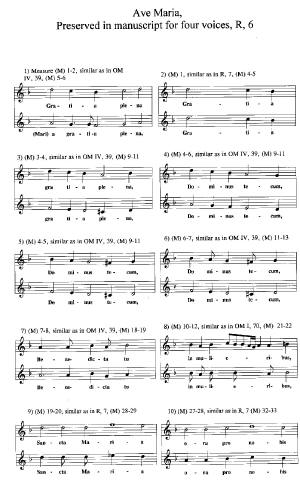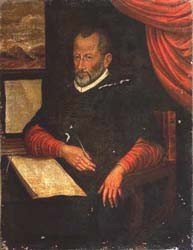Iacobus Gallus and the mystery of authorship
Who is the author of the Ave Maria motet for 4 voices?
Towards the end of December 2001 I received a copy of the
latest edition of Gallus' manuscripts, and saw to my great
surprise the Ave Maria motet under number 6 in the collection: It
is a composition I had always presumed to be the work of Tomas
Luis da Victoria.
How had the work had been ascribed to the Spanish composer?
Prominent Spanish musicologist Felipe Predrell had in 1913
published the eighth book of Victoria's complete works (Obras
Completas, Volumen III, Leipzig) and had included this motet. As
its only source he cited that it had been extracted from 'some old
manuscript' (de un antiguo manuscrito). When a newer edition of
Victoria's works was subsequently prepared by Higinio Angles, the
motet was conspicuous for its absence. It is not to be wondered at
therefore, that having followed Pedrell's earlier edition of
Victoria's works we had wrongly cited Victoria as the author of
this composition.

As the SAZU publication does not provide a close study of the
motet I decided to thoroughly analyze it in order to determine
whether the authorship is Victoria's or that of our own Gallus. In
doing so, I made a comparative study with the other four Ave Maria
motets of Gallus (OM I.70, double choir for 8 voices: OM IV.39,
six voices: OM IV.73, five voices, ad aequales: in manuscript for
six voices (in the SAZU 1996 edition musicologist Rudolf
Flotzinger on pages XI and XVIII incorrectly cites only two motets
of Gallus, omitting the already published OM IV.73): and with
Victoria's motet for eight voices and double choir, published in
1572.
Some of the discoveries made in the analysis are as follows:
1) The name of Gallus appears in the manuscript
(the MAMS edition provides a facsimile of this page).
2) The manuscript is located in the
University library of Graz, a city much closer to Gallus' extended
homeland than Rome, where Victoria had been active.
3) The text of the motet for four voices
(the traditional Ave Maria prayer) is the same as that of the
motet for six voices, also Gallus' work, and located in the same
library.
4) The score employs four chromatic tones
- F sharp, H, E flat, and C sharp. Gallus frequently proceeds in
such a manner - the four tones are found in 66.4% of his works -
but Victoria does not.
5) The different voices answer each other:
the tenor and bass in 8-10 time, the soprano, alto and tenor in
10-12 time. Gallus often used such melodic interventions, as for
example in Dies sanctificatus OM I.60, which is melodically
very similar. Victoria does not use such interventions.
6) In this motet ternary mensuration was
used, which is common to a fifth of all Gallus' motets. This is
much more than is evident in Victoria's works. Moreover the
Spaniard never used ternary mensuration in a short work such as
this. (Jan Andres,'Iacobus Gallus,introduccion a su musica' 1997,
pp.46-47)
7) Repetition of musical themes: the
measures 19-22 are repeated in the measures 23-26, and the
measures 27-28 are repeated in the two measures following, 29-30.
Victoria repeats the wording, but with a new musical design or
theme, while Gallus repeats the musical motifs in almost every
motet.
8) The use of the eighth (which also has its own
text) changes the melody and with this also the harmony.
Victoria never does this. The direct use of 'short' figures like
the eighth and sixteenth is one of Gallus'
most important musical characteristics,
and which distinguishes him from other musicians of the
Renaissance era. (Jan,A., op.cit. pp47-48)
9) In this motet diverse voices employ the same
rythm except in the measures 1-5, 12-17, and 34-37, when the
voices move in the same rythm two by two. The composer thus
employs the voices in 'classic' polyphony in only fifteen measures
(out of forty): in the remaining measures the voices create
harmonies.This is usual with Gallus, as his music is more harmonic
(vertical) while with Victoria the voices sing more in linear
fashion, melodically.
10) The motet ends in the harmonic major and
augmented third. Again this procedure is usual with Gallus but not
with Victoria, particularly as this motet is for four voices.
Victoria often ends a motet for four without the
third.(Jan,A.op.cit.p49-50."Amongst the motets there are only two
(0.5%) which end with the minor chord.Fourteen motets (3.7%)
display a final chord without the third. The remainder conclude
with the major chord, often with the augmented third. The final
chords may also have 2, 3 or even 4 thirds chromatically altered).
The final major chords are more frequent in Gallus' compositions
than in those of his contemporaries like Lassus, Victoria and
Palestrina.
11) There are very few 'empty' chords (as for
example in measures 3,6,8,10,18,32). Although there could be an
empty chord in the following measures 4,7,12,22,26,36,38, Gallus
employs the chromatic melodic extension in different voices in
order to arrive at the accord with the third (measures
12,22,26,38). This too is one of Gallus' chromatic
characteristics. Victoria never uses this extension.
12) At the end of the melody the voice ascends
in the following measures: 4,7,12,16,22,26,36,38. Meanwhile
Victoria usually uses a descending melody.
13) In the measures 21-22 and 25-26 there is in
the text a hemiolo, which is characteristic of Gallus' work.
(Jan,A.op.cit.pp46-47: "when Gallus uses tripartite mensuration he
almost always writes a hemiolo at the
conclusion of the melodic phrase. The hemiolo was 'fashionable' in
the Baroque, even before the change from
ternary to binary mensuration. We first see it in the Credo of the
Mass Elizabeth Zachariae, SQM II,2: while
the most original is found in the motet Ecce concipies OM I,24").
14) The Gregorian intonation with which the
motet begins is as unusual for Gallus as for Victoria. Gallus has
it only in the manuscripted motet Veni Sancte Spiritus, but we do
not find it in the OM. Meanwhile both
composers used Gregorian intonation in the Gloria and Credo of the
Mass.
15) This motet has many melodic variants in
common with the motet for six voices (from the same archive) and
the Ave Marias published in the Opus Musicum, I.70; IV.39, (but
not to the composition OM IV.73). In the
attached sample of measures a comparison is made between the
motets for four and six voices, with two
of the motets established to be by
Gallus). Meanwhile there is no musical similarity between
Victoria's motet for eight voices and the
manuscript Ave Maria motet for four.
16) The manuscripted Ave Maria for six voices
may serve as the bridge between the score for four voices and
two Ave Maria motets of the OM, see above. In the score for six we
find these characteristics of Gallus:
eighths with independent text and changing of melody (and with it
the harmony): use of the augmented fifth accord, measure 25
(Jan,A.op.cit.p49): sequential accords in three places
(Jan,A.op.cit.p52) in the measures 24-25 (B,C,and D major),
measures 33 (D minor, C and B major), and in measures 33-34 (D,C,and
B major):leap of the fourth in measure 39 (Jan,A.op.cit.p34):four
altered notes: and major concluding
accord.
It is thus possible to conclude from this musical and textual
analysis that Gallus was the author of the Ave Maria motet for
four voices.
Translated into English by Sonja Vadnjal
Bibliography
*(manuscript was published by MONUMENTA ARTIS MUSICAE SLOVENIAE in Ljubljana, 1996)




